
Sapphire Radeon 9100 Atlantis

The Sapphire Radeon 9100 Atlantis is equipped with 128MB of DDR memory and features 4 rendering pipelines, 128bit memory bus, and clocked at 250MHz core speed with a 200MHz or 400DDR memory speed. The 128MB of DDR memory is comprised of eight 16MB memory chips rated at 5ns on both sides of the card by AData. As far as AGP specifications are concerned, the card supports up to AGP4X.
Compared to a Radeon 9700, the card has half the memory bus width and the memory speed is a quite a bit slower. With the 9700 Pro, the Radeon 9100 falls short in the same category along with being clocked slower. The clock on a 9700 Pro runs at 325MHz and the memory is at 310MHz or 620DDR. Price wise, the 9100 Pro runs around $80 and the 9700 Pro comes in at a $300.
Video output comes in three flavors: DVI, S-Video, and VGA. The card does support dual display utilizing Hydravision technology. Since I work with Hydravision at work, I can say that the implementation of dual display with it is pretty good. Rather than get into all the features that Hydravision has, I will just say that for dual monitor work the software does a great job.
Bundled with the card is just the driver CD and a Component to S-Video adapter. I would’ve liked to see a game or two thrown in there but seeing as this is a value card, they wanted to keep costs down.
My test system consisted of:
AMD XP 2400+
1024MB PC2100 Muskin High Perf. Memory 2-2-2
Windows XP w/ DirectX 9.0
MSI KT3 Ultra2 Motherboard
M-Audio Revolution 7.1
120GB WD 7200rpm 8MB cache
For drivers, I opted for the latest Catalyst version, which is version 3.1, which were posted February 10, 2003. You can pick up the drivers here. For comparison, I threw in the results from my Radeon 9700. Even though these cards are in two different market segments, it’ll be nice to see how much extra you get for the price premium of a power card like the 9700pro. Let’s start off with the tried and true 3DMark2001 SE from Futuremark.
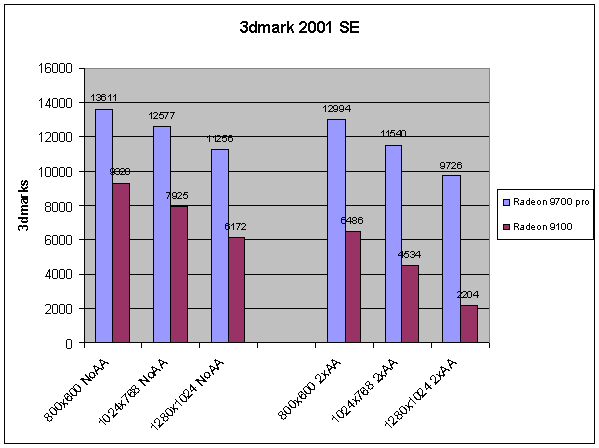
Try not to be too down on the 9100 as it is going against a 9700 pro. For an $80 card, it does pretty good as long as No AA is on.Now let’s see how the two cards compare with Unreal Tournament 2003 which utilizes DirectX. Thanks to HardOCP for making a benching utility for this game that makes reviewers’ lives easier. This first chart is low quality with no anti-aliasing.
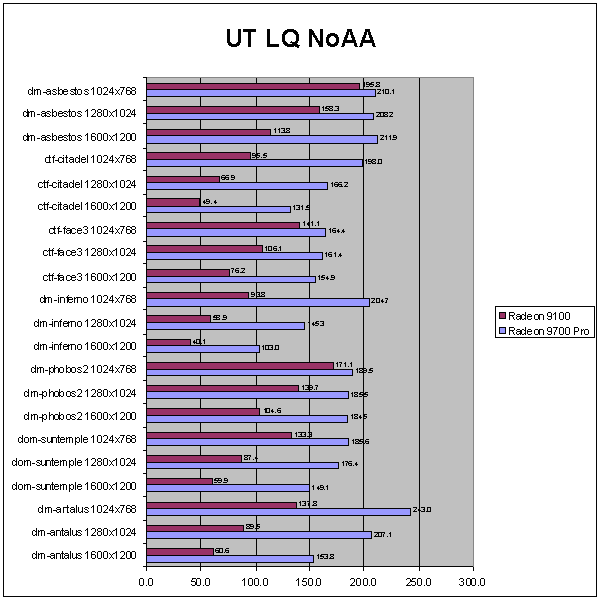
As you can see, UT2K3 is totally playable at 1024x768 on this card. The difference between LQ and HQ isn’t all that noticeable when you have 4 rockets are coming at your face.
Here is low quality with 2x anti-aliasing on.
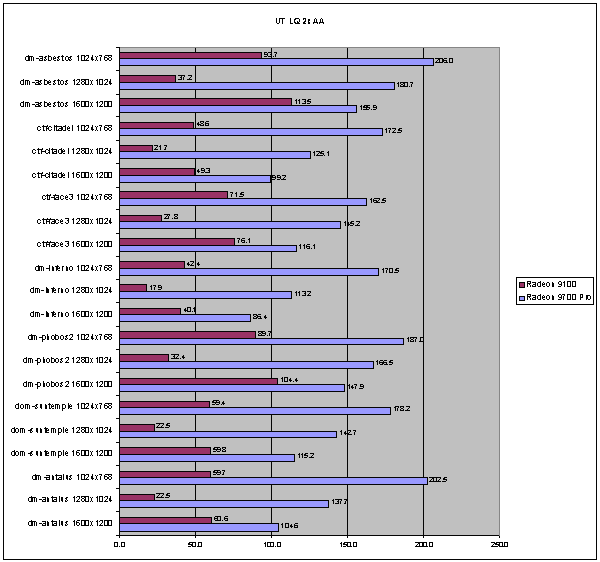
As you can see, this card isn’t really made to be used with AA on, even at the 2x level. You could probably play on some smaller maps with 2x on, but not the large ones.The next benchmark is Comanche 4 demo from Novalogic. It has scripting ability in which you can programmatically run many benchmarks in a batch. Yet another tool nice for reviewers.
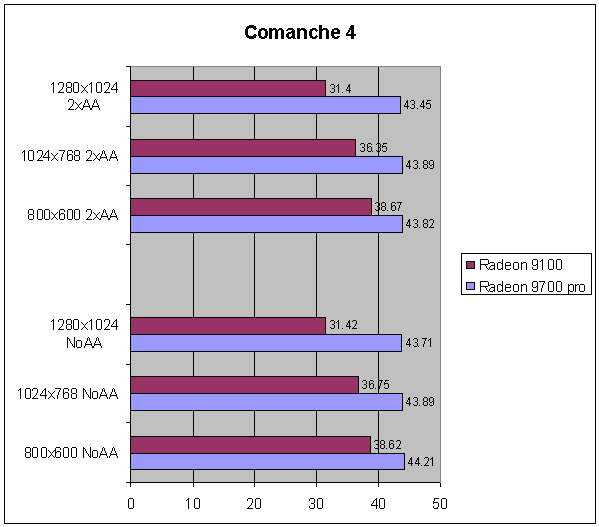
Here we see in this test that there is some kind of other system bottleneck at lower resolutions, but looking at the higher resolutions, the 9100 drops off as 4-5 fps in this benchmark is pretty huge.
The last benchmark today is VulpineGL. This benchmark utilizes OpenGL. ATI is notorious for having bad OpenGL implementation in their drivers. The latest set fixed a stutter bug in OpenGL games so let’s see how it does now.
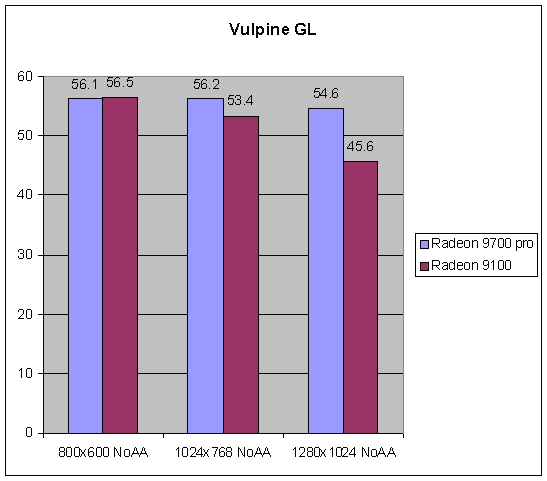
Here we see at 800x600 that the video card isn’t the bottleneck, but the 9100 starts to taper off even at 1024.
In conclusion, the Sapphire 9100 Pro is a decent card for the gamer on an extremely low budget that doesn’t play too many fast action games. Just don’t expect to play at any higher resolutions either. At the price point of $80, it’s the best card you’re going to get at that price range, but if you want to play any recent games such as Battlefield 1942 or Freelancer, I would recommend shoveling snow in some more driveways and saving for the Sapphire Atlantis 9500 Pro. I give this card an 8. It’s a decent card, but I don’t think it will last the gamer very long with upcoming games. There is also no DX9 hardware support, so I think a 9500 Pro would last much longer.
Rating: 8 Good
* The product in this article was sent to us by the developer/company.

About Author
I've been playing games ever since Atari 2600. I play mostly FPS games now. I used to play just about all types. I went to CPL in Winter 2001 to play Aliens vs Predator 2 and placed 11th. The free Geforce3 TI500 was nice. Despite being jealous of Fata1ty, he's actually a nice guy.
I'm also a computer hardware addict. I'm one of those people that have to update my machine for the sake of having the best out of the people I know. Still cheaper than being married :) It gives me an opportunity to review some of the latest and greatest hardware. I'm currently playing Battlefield 1942 in a top clan, Medal of Honor Allied Assault sometimes, Unreal Tournament 2003 occasionally, and trying various other games when given the time. Still waiting patiently for Planetside. View Profile